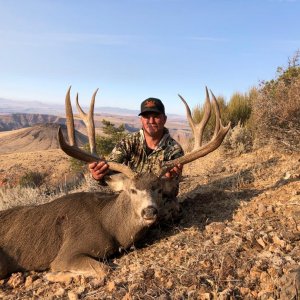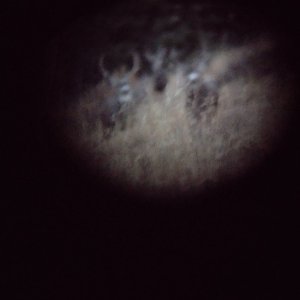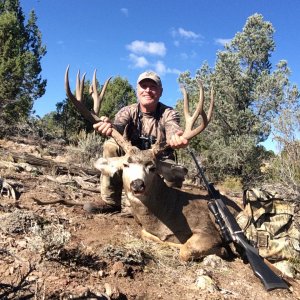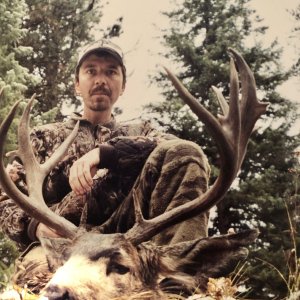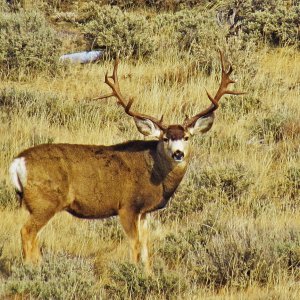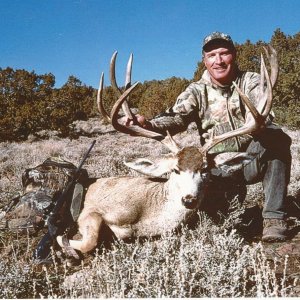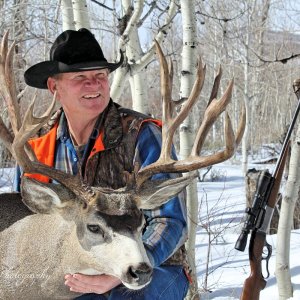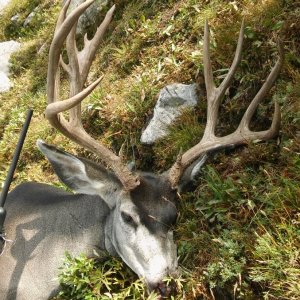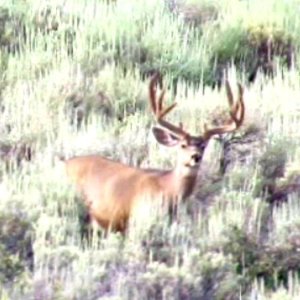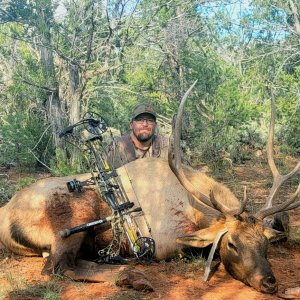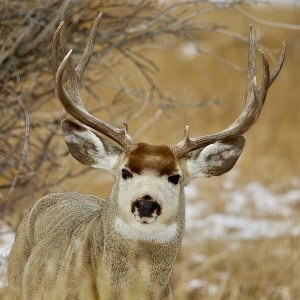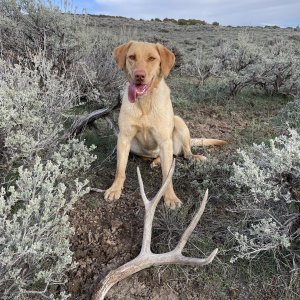Utah Landowner Permits Regs... ( I can't understand them)
Rule R657-43. Landowner Permits.
As in effect on December 1, 2008
Table of Contents
R657-43-1. Purpose and Authority.
R657-43-2. Definitions.
R657-43-3. Qualifications for General Landowner Buck Deer Permits.
R657-43-4. Qualifications for Limited Entry Permits.
R657-43-5. Application for General Landowner Buck Deer Permits.
R657-43-6. Application for Limited Entry Permits.
R657-43-7. General Permits and Season Dates.
R657-43-8. Limited Entry Permits and Season Dates.
R657-43-9. Limited Entry Permit Allocation and Fees.
R657-43-10. Limited Entry Permit Conflict Resolution.
(1) Under authority of Sections 23-14-18 and 23-14-19, this rule provides the standards and procedures for private landowners to obtain landowner permits for:
(a) taking buck deer within the general regional hunt boundary area where the landowner's property is located during the general deer hunt only; and
(b) taking bull elk, buck deer or buck pronghorn within a limited entry unit.
(2) In addition to this rule, any person who receives a landowner permit must abide by Rule R657-5 and the proclamation of the Wildlife Board for taking big game.
(3) The intent of the general landowner buck deer permit is to provide an opportunity for landowners, lessees, or their immediate family, whose property provides habitat for deer, to purchase a general deer permit for the general regional hunt boundary area where the landowner's property is located.
(4) The intent of the limited entry landowner permit is to provide an opportunity for landowners, whose property provides habitat for deer, elk, or pronghorn, to be allocated a restricted number of permits for a limited entry bull elk, buck deer, or buck pronghorn unit, where the landowner's property is located. Allowing landowners a restricted number of permits:
(a) encourages landowners to manage their land for wildlife;
(b) compensates the landowner for providing private land as habitat for wildlife; and
(c) allows the division to increase big game numbers on specific units.
R657-43-2. Definitions.
(1) Terms used in this rule are defined in Section 23-13-2.
(2) In addition:
(a) "Eligible property" means:
(i) private land that provides habitat for deer, elk or pronghorn as determined by the division of Wildlife Resources;
(ii) private land that is not used in the operation of a Cooperative Wildlife Management Unit;
(iii) private land that is not used in the operation of an elk farm or elk hunting park;
(iv) land in agricultural use as provided in Section 59-2-502 and eligible for agricultural use valuation as provided in Sections 59-2-503 and 59-2-504; and
(v) for the purpose of receiving general buck deer permits, a minimum of 640 acres of private land owned or leased by one landowner within the general regional hunt boundary; or
(vi) private land, including crop land owned by members of a landowner association for limited entry permits.
(b) "Immediate family" means the landowner's or lessee's spouse, children, son-in-law, daughter-in- law, father, mother, father-in-law, mother-in-law, brother, sister, brother-in-law, sister-in-law, stepchildren, and grandchildren.
(c) "Landowner" means any person, partnership, or corporation who owns property in Utah and whose name appears on a deed as the owner of eligible property or whose name appears as the purchaser on a contract for sale of eligible property.
(d) "Landowner association" means an organization of private landowners who own property within a limited entry unit, organized for the purpose of working with the division.
(e) "Lessee" means any person, partnership, or corporation whose name appears as the Lessee on a written lease, for at least a one-year period, for eligible property used for farming or ranching purposes, and who is in actual physical control of the eligible property.
(f) "Limited entry unit" means a specified geographical area that is closed to hunting deer, elk or pronghorn to any person who has not obtained a valid permit to hunt in that unit.
(g) "Voucher" means a document issued by the division to a landowner, landowner association, or Cooperative Wildlife Management Unit operator, allowing a landowner, landowner association, or Cooperative Wildlife Management Unit operator to designate who may purchase a landowner big game hunting permit from a division office.
R657-43-3. Qualifications for General Landowner Buck Deer Permits.
(1) The director, upon approval of the Wildlife Board, may establish a number of general landowner buck deer permits within each region to be offered to eligible landowners or lessees for the general deer hunting season only.
(2) Only private lands will be considered in qualifying for general landowner buck deer permits. Public or state lands are not eligible.
(3) Crop lands will be considered in qualifying for general landowner buck deer permits if the crop lands provide habitat for deer and contribute to meeting unit management plan objectives.
(4) General landowner buck deer permits are limited to resident or nonresident landownersor lessees, and members of their immediate family.
R657-43-4. Qualifications for Limited Entry Permits.
(1) The Director, upon approval of the Wildlife Board, may establish a number of bull elk, buck deer and buck pronghorn limited entry permits to be offered to an eligible landowner association.
(2) Limited entry landowner permits are available for taking buck deer, bull elk or buck pronghorn, and may only be used on designated limited entry units.
(3) Only private lands that do not qualify for Cooperative Wildlife Management Units will be considered for limited entry landowner permits. Public or state lands are not eligible.
(4) Only private lands that qualify as eligible property will be considered for limited entry landowner permits.
(5) Applications for limited entry landowner permits will be received from landowner associations only.
(6) Only one landowner association, per species, may be formed for each limited entry unit as follows:
(a) A landowner association may be formed only if a simple majority of landowners, representing 51 percent of the eligible private lands within the herd unit, enter into a written agreement to form the association.
(b) The association may not unreasonably restrict membership to other qualified landowners in the unit.
(c) Each landowner association must elect a chairperson to represent the landowner association.
(d) The landowner association chairperson shall act as liaison with the division and the Wildlife Board.
(e) A landowner or landowner association may not restrict legal established passage through private land to access public lands for the purpose of hunting.
R657-43-5. Application for General Landowner Buck Deer Permits.
(1) Applications for general landowner buck deer permits are available from division offices.
(2) Only one eligible landowner or lessee may submit an application for the same parcel of land within the respective general regional hunt boundary area.
(3) In cases where more than one application is received for the same parcel of land, all applications will be rejected.
(4) Applications must include:
(a) total acres owned within the respective general regional hunt boundary area;
(b) signature of the landowner; and
(c) location of the private lands, acres owned, county and region.
(5) In cases where the landowner's or lessee's land is in more than one general regional hunt boundary area, the landowner or lessee may select one of those regions from which to receive the permit.
(6) a non-refundable handling fee must accompany each application.
(7) a landowner may not apply for or obtain a general landowner buck deer permit without possessing a Utah hunting or combination license.
(8) Applications will be available by January 7.
(9) Applications must be completed and returned to the regional division office.
(10) The signature on the application will serve as an affidavit certifying ownership.
R657-43-6. Application for Limited Entry Permits.
(1) Applications for limited entry landowner permits are available from division offices and from division wildlife biologists.
(2) Applications to receive limited entry landowner permits must be submitted by a landowner association for lands within the limited entry hunt unit where the private lands are located.
(3) Applications must include:
(a) total acres owned by the association within the limited entry hunting unit and a map indicating the privately owned big game habitat;
(b) signature of each of the landowners within the association including acres owned, with said signature serving as an affidavit certifying ownership;
(c) a distribution plan for the allocation of limited entry permits by the association;
(d) a copy of the association by-laws; and
(e) a non-refundable handling fee.
(4) The division shall, upon request of the applicant, provide assistance in preparing the application.
(5) Applications must be completed and returned to the appropriate division office by September 1 annually.
(6) The division shall forward the application and other documentation to the Regional Wildlife Advisory Councils for public review.
(7) Recommendations by the Councils will then be forwarded to the Wildlife Board for review and action.
(8) Upon approval by the Wildlife Board, a Certificate of Registration will be issued to the landowner association.
R657-43-7. General Permits and Season Dates.
(1) The following number of general landowner buck deer permits may be available to a landowner or lessee:
(a) one general landowner buck deer permit may be issued for eligible property of 640 acres; and
(b) one additional general landowner buck deer permit may be issued for each additional 640 acres of eligible property.
(c) If an individual has both owned and leased eligible property, the acreage may be combined in determining the number of permits to be issued.
(2) Permittees may select only one general landowner buck deer permit (archery, rifle or muzzleloader) as provided in the proclamation of the Wildlife Board for taking big game.
(3)(a) General landowner buck deer permits are for personal use only and may not be transferred to any other person.
(b) If the landowner or lessee is a corporation, the person eligible for the permit must be a shareholder, or immediate family member of a shareholder, designated by the corporation.
(4) Any person who is issued a general landowner buck deer permit under this rule is subject to all season dates, weapon restrictions and any other regulations as provided in the proclamation of the Wildlife Board for taking big game.
(5) The fee for a general landowner buck deer permit is the same as the fee for a general season, general archery or general muzzleloader buck deer permit.
(6) Nothing in this rule shall be construed to allow any person to obtain more than one general buck deer permit from any source or take more than one buck deer during any one year.
(7) Permits will be issued beginning in June, in the order that applications are received, and permits will continue to be issued until all permits for each region have been issued.
(8) to receive a general landowner buck deer permit, the eligible person must possess or obtain a Utah hunting or combination license.
R657-43-8. Limited Entry Permits and Season Dates.
(1) Only bull elk, buck deer or buck pronghorn limited entry permits may be applied for by the landowner association.
(2)(a) The division and landowner chairperson shall jointly recommend the number of permits to be issued to the landowner association.
(b) When consensus between the landowner chairperson and the division is not reached, applications shall include justification for permit numbers for review by the Wildlife Regional Advisory Councils and the Wildlife Board.
(3) Permit numbers shall fall within the herd unit management guidelines. Permit numbers will be based on:
(a) the percent of private land big game habitat within the unit that is used by wildlife; or
(b) the percentage of use by wildlife on the private lands.
(4) Landowners receiving vouchers may personally use the vouchers or reassign the vouchers to any legal hunter.
(5) All landowners who receive vouchers, and transfer the vouchers to other hunters must:
(a) allow those hunters receiving the vouchers access to their private lands for hunting; and
(b) allow the same number of public hunters with valid permits, equal to the number of vouchers transferred, to access the landowner association's private land for hunting during the appropriate limited entry bull elk, buck deer or buck pronghorn hunting season, except as provided in Subsection (6).
(6)(a) Landowners who transfer vouchers to other hunters may deny public hunters access to the landowner association's private land for hunting by requesting, through the landowner association, a variance to Subsection (5)(b) from the Wildlife Board.
(b) The requested variance must be provided by the landowner association in writing to the division 30 days prior to the appropriate Regional Advisory Council meeting scheduled to review Rule R657-5 and the Bucks, Bulls and Once-in-a-lifetime proclamation of the Wildlife Board for taking big game.
(c) The variance request must be presented by the landowner association to the appropriate local Regional Wildlife Advisory Council. The local Regional Wildlife Advisory Council shall forward a recommendation to the Wildlife Board for consideration and action.
(7)(a) Any person who is issued a limited entry landowner permit must follow the season dates, weapon restrictions and any other regulations governing the taking of big game as specified in Rule R657-5 and the proclamation of the Wildlife Board for taking big game.
(b) to receive a limited entry landowner permit, the person designated on the voucher must possess or obtain a Utah hunting or combination license.
(8) A limited entry landowner permit authorizes the permittee to hunt within the limited entry unit where the eligible property is located.
(9) Nothing in this rule shall be construed to allow any person, including a landowner, to take more than one buck deer, one bull elk or one buck pronghorn during any one year.

